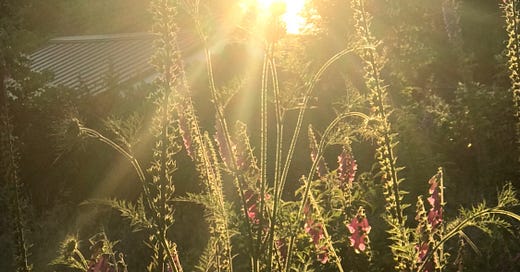Glimmer is a lovely word, isn’t it? It sounds like the twinkle of fairy lights ✨✨
Glimmers are actually a real thing—a concept that comes out of the work around polyvagal theory. You’ve heard the term being “triggered” before? Being upset or negatively activated by something?
Well, glimmers are considered the opposite of triggers. They are small things or moments that help calm your system—moments of pleasure, delight, or joy. Maybe it’s the smell of fresh bread that reminds you of that great bakery you found on vacation, or a song that happens to be your road trip anthem, or anything that reminds you of a dear friend or loved one. It’s a hug, or taking a moment to enjoy your cup of tea or coffee, it’s the soft ears of your dog, it’s all the warm fuzzies. Glimmers are a bit of light in the dark.
There’s a lot more I could tell you about how glimmers help your nervous system move up the ladder into a ventral state, but the upshot is this: sprinkling your days with glimmers is going to make you feel better, calmer, more at peace.
I know this because for the past two months I’ve been doing just that.
I’m taking a class where it was suggested that we set a reminder to partake in glimmers. Often glimmers are spontaneous, but you can also seek out that sort of delight or pleasure. I can wait for my favorite road trip song to play, or I can press play myself.
So, I made a list of easily accessible glimmers—having a quick dance party by myself, doing some yoga stretches, smelling flowers, cuddling the dog, reaching out to a friend, going for a walk. Nothing complicated, nothing would take more than ten minutes (well, the walk might).
Then, I set some alarms—11am, 3pm. Now, when the alarm goes off, I take a short break and do something from the list. When the alarm goes off, it’s glimmer time ✨✨
[Did I just say that in my head to the tune of “Hammer-time?” Yes, yes I did.]
Given the stress and state of the world right now, I can tell the glimmers are helping. I feel better than I would have expected, calmer, more grounded. It’s been remarkable.
Often now, when the alert goes off, I am already doing my glimmer behavior—already on a walk or dancing around or writing a brief note to a friend (a quick postcard is a perfect glimmer activity for me). Those are my gold star moments—when I can see I’ve woven glimmers into my life without effort.
If you want to learn more about glimmers, here is an article to read, or you could jump into a book by Deb Dana, who coined the term “glimmer,” or listen to a podcast interview with her. I appreciate that this concept came from her work with complex trauma patients. This is not fuffy stuff.
"We're not talking great, big, expansive experiences of joy or safety or connection," Dana says. "These are micro moments that begin to shape our system in very gentle ways."
Micro moments of goodness.
The other thing I think is good to know is that we humans are wired to be on the constant lookout for what is threatening or dangerous—this is how we survived and evolved. So we automatically notice bad and scary things. Developing a habit of noticing glimmers is a positive counterbalance to that. Not only can we survive, we can also thrive.
Fostering glimmers can help make our days better, brighter. Perhaps you’d like to get on the Glimmer Train as well. I’ll save you a seat, if you’d like.
How about you—have you heard of glimmers? Are you doing anything to cultivate them?
Wishing you the most glimmery week possible.
—Tara ✨✨
To learn more:
How to Embrace Glimmers (USA Today)
What is a Glimmer? (Deb Dana’s website)
Glimmers: How to Trigger Feelings of Joy and Safety (VeryWellMind)
Glimmer video going viral on TikTok (Dr. Justine Grosso)
Something else to enjoy: my books







I am now! The swaying Juniper out my window. The first sip of hot tea.
Love this. For me, receiving a card or letter in the mail. Checking out a new library book (even if I know I won't have time to read it). A Saturday morning yoga class, with the whole weekend ahead of me.